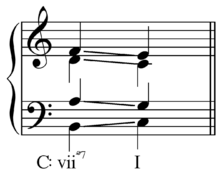Leading-tone seventh chord




In music theory, the leading-tone seventh chords are viiø7 and viio7,[1] the half-diminished and diminished seventh chords on the seventh scale degree, or leading-tone, in major and harmonic minor, resolving to the tonic. Leading-tone triads and seventh chords are frequently substituted for dominant chords, with which they have three common tones, for variety.[2]
The leading-tone seventh chord is half diminished in C major (B-D-F-A) and fully diminished in C minor (B-D-F-A♭). However, composers throughout the Common practice period often employed modal mixture when using the leading-tone seventh chord in a major key, allowing for the substitution of the half-diminished seventh chord for the fully diminished seventh chord. This mixture is commonly used when the leading-tone seventh chord is functioning as a secondary leading-tone chord. The leading-tone seventh chord contrasts with the subtonic seventh chord in that the subtonic has a flatted seventh (chord root): in C minor, B♭-D-F-A♭.
Fétis tunes the leading-tone seventh in major 5:6:7:9.[3]